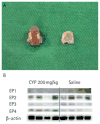Expression of E-series prostaglandin (EP) receptors and urodynamic effects of an EP4 receptor antagonist on cyclophosphamide-induced overactive bladder in rats
- PMID: 20346049
- PMCID: PMC3102303
- DOI: 10.1111/j.1464-410X.2010.09260.x
Expression of E-series prostaglandin (EP) receptors and urodynamic effects of an EP4 receptor antagonist on cyclophosphamide-induced overactive bladder in rats
Abstract
Objective: To investigate the expression of four subtypes of E-series prostaglandin (EP(1) -EP(4) ) receptors and the urodynamic effects of an EP(4) receptor antagonist (AH23848) in cyclophosphamide (CYP)-induced overactive bladder (OAB) in rats, as intravesical prostaglandin E(2) (PGE(2) ) induces OAB via activation of EP receptors and sensitization of afferent nerves.
Materials and methods: Experimental and control rats were injected with CYP (200 mg/kg, intraperitoneally) or saline, respectively. Continuous cystometrograms (CMGs) were performed 48 h after CYP or saline injection under urethane anaesthesia. AH23848 was given intravenously at doses of 0.01 and 0.1 mg/kg. The bladder was then harvested for histology. Some bladders were harvested for analysis of EP receptors expression by Western blotting without a CMG study. CMG variables (baseline pressure; intercontraction interval [ICI], pressure threshold [PT], contraction amplitude) and histological changes were measured.
Results: CYP-induced up-regulation of EP(4) receptor (100% increase) accompanied by detrusor overactivity (ICI 70.5% decrease; PT, 67.7% increase). However, CYP down-regulated EP(1) receptor expression (51.9% decrease), but had no significant effects on the EP(2) and EP(3) receptors. AH23848 significantly extended the ICI in CYP-treated rats but it had no effects on other urodynamic variables or in control rats.
Conclusions: Modulation of EP receptors plays a role in CYP-induced OAB. Antagonists to the EP(4) receptor may be a new target for treatment of patients with OAB.
© 2010 THE AUTHORS. JOURNAL COMPILATION © 2010 BJU INTERNATIONAL.
Conflict of interest statement
Yao-Chi Chuang is a consultant and investigator for Allergen and Pfizer, Naoki Yoshimara is a consultant for Astellas, Pradeep Tyagi is a consultant for Lipella, and Michael B. Chancellor is a consultant for Pfizer, Astellas and Allergen.
Figures



Similar articles
-
Mechanisms and urodynamic effects of a potent and selective EP4 receptor antagonist, MF191, on cyclophosphamide and prostaglandin E2-induced bladder overactivity in rats.BJU Int. 2012 Nov;110(10):1558-64. doi: 10.1111/j.1464-410X.2012.11096.x. Epub 2012 Mar 27. BJU Int. 2012. PMID: 22452546
-
Intravesical botulinum toxin A administration inhibits COX-2 and EP4 expression and suppresses bladder hyperactivity in cyclophosphamide-induced cystitis in rats.Eur Urol. 2009 Jul;56(1):159-66. doi: 10.1016/j.eururo.2008.05.007. Epub 2008 May 20. Eur Urol. 2009. PMID: 18514386
-
The role of prostaglandin and E series prostaglandin receptor type 4 receptors in the development of bladder overactivity in a rat model of chemically induced prostatic inflammation.BJU Int. 2019 Nov;124(5):883-891. doi: 10.1111/bju.14845. Epub 2019 Jun 26. BJU Int. 2019. PMID: 31166645 Free PMC article.
-
Urodynamic effects of a novel EP(1) receptor antagonist in normal rats and rats with bladder outlet obstruction.J Urol. 2007 Apr;177(4):1562-7. doi: 10.1016/j.juro.2006.11.070. J Urol. 2007. PMID: 17382779
-
PGE2 receptors in detrusor muscle: Drugging the undruggable for urgency.Biochem Pharmacol. 2021 Feb;184:114363. doi: 10.1016/j.bcp.2020.114363. Epub 2020 Dec 9. Biochem Pharmacol. 2021. PMID: 33309520 Free PMC article. Review.
Cited by
-
Investigations of urethral sphincter activity in mice with bladder hyperalgesia before and after drug administration of gabapentin.Int Urol Nephrol. 2019 Jan;51(1):53-59. doi: 10.1007/s11255-018-2021-8. Epub 2018 Nov 1. Int Urol Nephrol. 2019. PMID: 30387068 Free PMC article.
-
The role of prostanoids in urinary bladder physiology.Nat Rev Urol. 2012 Mar 13;9(5):283-90. doi: 10.1038/nrurol.2012.33. Nat Rev Urol. 2012. PMID: 22410675 Review.
-
Functional and molecular characterization of hyposensitive underactive bladder tissue and urine in streptozotocin-induced diabetic rat.PLoS One. 2014 Jul 22;9(7):e102644. doi: 10.1371/journal.pone.0102644. eCollection 2014. PLoS One. 2014. PMID: 25050870 Free PMC article.
-
Suppression of Inflammatory and Fibrotic Signals by Cinnamon (Cinnamomum cassia) and Cinnamaldehyde in Cyclophosphamide-Induced Overactive Bladder in Mice.Evid Based Complement Alternat Med. 2021 Dec 22;2021:5205759. doi: 10.1155/2021/5205759. eCollection 2021. Evid Based Complement Alternat Med. 2021. PMID: 34976095 Free PMC article.
-
Sensory dysfunction of bladder mucosa and bladder oversensitivity in a rat model of metabolic syndrome.PLoS One. 2012;7(9):e45578. doi: 10.1371/journal.pone.0045578. Epub 2012 Sep 19. PLoS One. 2012. PMID: 23029112 Free PMC article.
References
-
- Andersson KE, Wein AJ. Pharmacology of lower urinary tract: basis for current and future treatments of urinary incontinence. Pharmacol Rev. 2004;56:581–631. - PubMed
-
- Lee T, Andersson KE, Streng T, Hedlund P. Simultaneous registration of intraabdominal and intravesical pressures during cystometry in conscious rats – effects of bladder outlet obstruction and intravesical PGE2. Neurourol Urodyn. 2008;27 :88–95. - PubMed
-
- Lee T, Hedlund P, Newgreen D, Andersson KE. Urodynamic effects of a novel EP(1) receptor antagonist in normal rats and rats with bladder outlet obstruction. J Urol. 2007;177:1562–7. - PubMed
-
- Schussler B. Comparison of the mode of action of prostaglandin E2 (PGE2) and sulprostone, a PGE2-derivative, on the lower urinary tract in healthy women. A urodynamic study. Urol Res. 1990;18:349–52. - PubMed
-
- Kim JC, Park EY, Seo SI, Park YH, Hwang TK. Nerve growth factor and prostaglandins in the urine of female patients with overactive bladder. J Urol. 2006;175:1773–6. - PubMed
Publication types
MeSH terms
Substances
Grants and funding
LinkOut - more resources
Full Text Sources
Other Literature Sources
Medical

